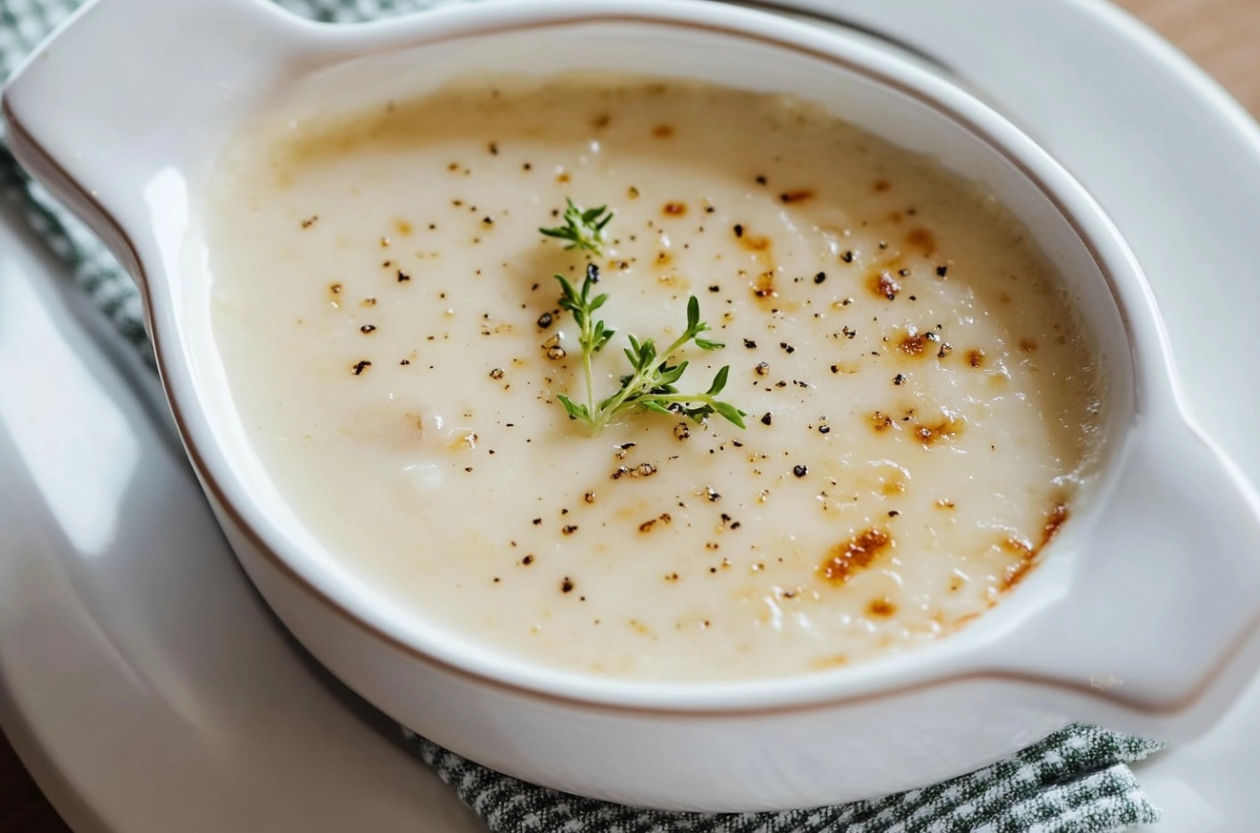Introduction to Béchamel Sauce Recipe
Béchamel sauce recipe is one of the most important mother sauces in French cuisine. This white, rich, and creamy sauce serves as the foundation for many other culinary preparations. From creamy gratins to savory croquettes, béchamel sauce infuses each dish with a distinct and delightful flavor.
Origin of Béchamel Sauce
Béchamel sauce has its roots in 17th-century French gastronomy. Although its exact origin is uncertain, it is believed to have been created in honor of the Marquis de Béchamel. Now a global favorite, this sauce has transcended its origins to become a staple in cuisines around the world. To learn more about the variations and uses of béchamel sauce, you can visit serious eats.
Versatile Uses of Béchamel Sauce
Béchamel sauce recipe is known for its versatility in cooking. It is used not only as a base for other sauces, like Mornay sauce, but also in dishes like lasagna, moussaka, and soufflés. Its smooth texture allows it to easily blend with other ingredients, creating layers of flavor in any recipe. To discover more ways to use béchamel sauce, check out these béchamel sauce variations at BBC Good Food. Utilize this guide to discover innovative methods to incorporate béchamel sauce into your culinary creations.
Importance in Modern Cooking
Today, béchamel sauce remains a fundamental component in many recipes around the world. Its simplicity and richness allow cooks of all levels to experiment and create unique dishes. Whether you’re preparing a classic French dish or a homemade meal, béchamel sauce adds depth and flavor to your culinary creations.
Basic Recipe and Preparation
Print
Classic Béchamel Sauce
- Total Time: 15 minutes
- Yield: About 2 cups
- Diet: Vegetarian
Description
A step-by-step guide to creating the smooth, creamy base for numerous dishes.
Ingredients
- Butter: 5 tablespoons
- Flour: ¼ cup all-purpose
- Milk: 1 quart
- Salt: 1 teaspoon, adjust to taste
- Nutmeg: ¼ teaspoon, freshly grated
Instructions
- Begin by melting the butter in a medium saucepan over medium heat. Ensure the butter does not brown, as this could alter the flavor of your Béchamel.
- Sprinkle the flour over the melted butter, whisking continuously to form a smooth paste. This mixture, known as a roux, is the thickening base for your sauce.
- Gradually add the milk to the roux while continuously stirring to prevent any lumps. Once all the milk is incorporated, bring the mixture to a simmer.
- Continue to cook, stirring frequently, until the sauce thickens and coats the back of a spoon, which should take about 6 to 8 minutes.
- Season with salt and the freshly grated nutmeg. Adjust the seasoning according to your preference.
Notes
- For a thinner sauce, reduce the flour or increase the milk slightly.
- The sauce can be flavored with additional spices or cheese for a richer taste.
- Prep Time: 5 minutes
- Cook Time: 10 minutes
- Category: Sauce
- Method: Stovetop
- Cuisine: French
Nutrition
- Serving Size: 1/2 cup
- Calories: 120
- Sugar: 4g
- Sodium: 200mg
- Fat: 9g
- Saturated Fat: 5g
- Unsaturated Fat: 3g
- Trans Fat: 0g
- Carbohydrates: 8g
- Fiber: 0g
- Protein: 3g
- Cholesterol: 25mg
Keywords: Béchamel Sauce
STEPS
Step 1
Gather all ingredients.
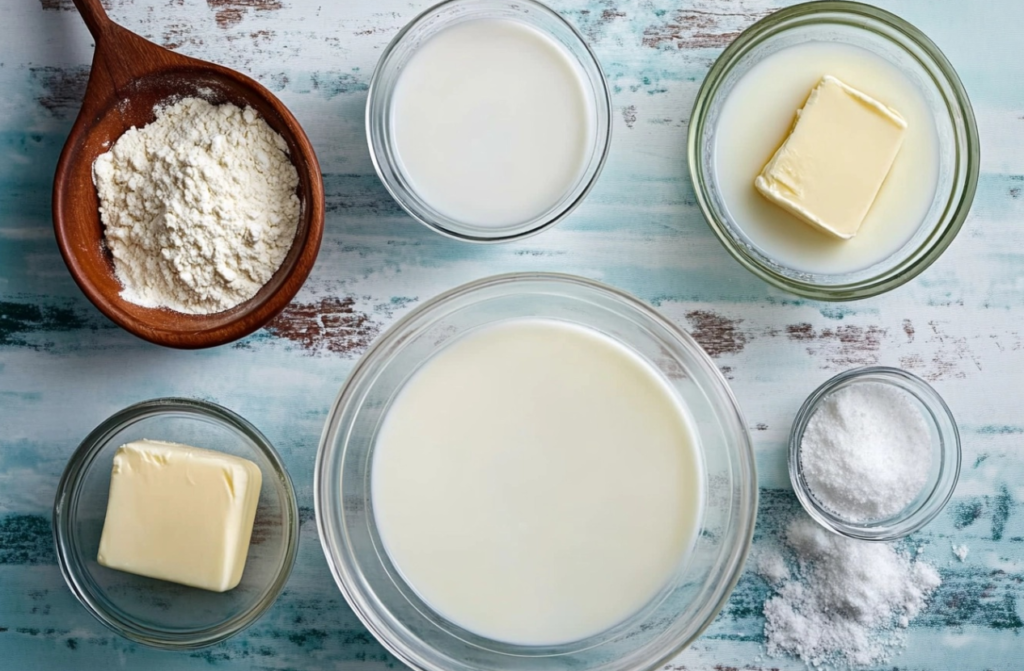
Step 2
In a sizeable saucepan set over medium heat, melt the butter. Introduce the flour and blend it with the melted butter using a whisk to achieve a smooth consistency. Stir and cook until the flour adopts a pale, golden hue reminiscent of sand, which takes about 7 minutes.
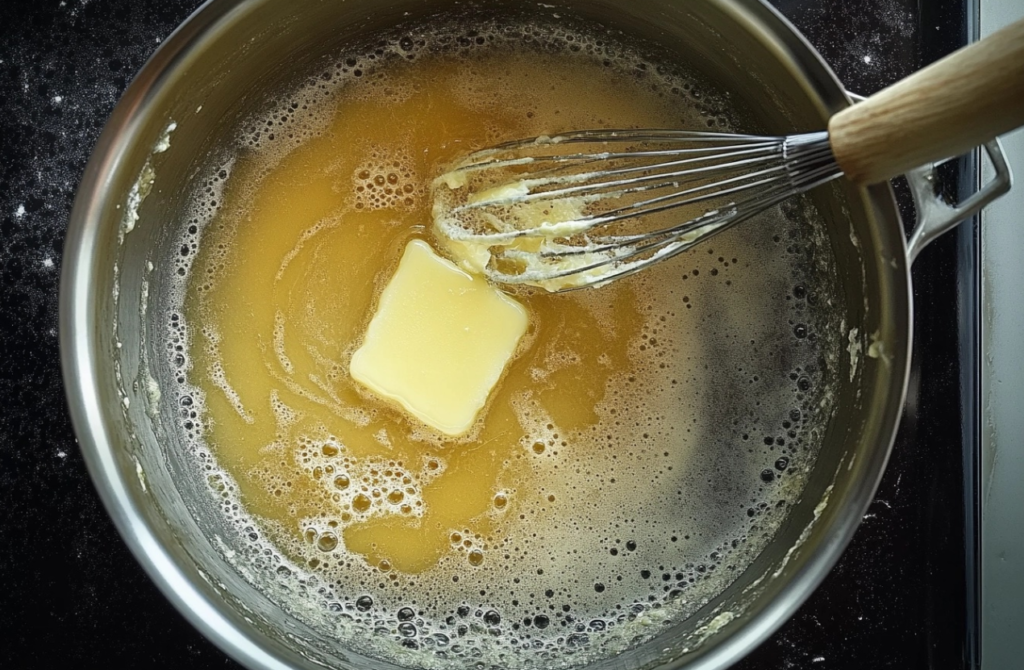
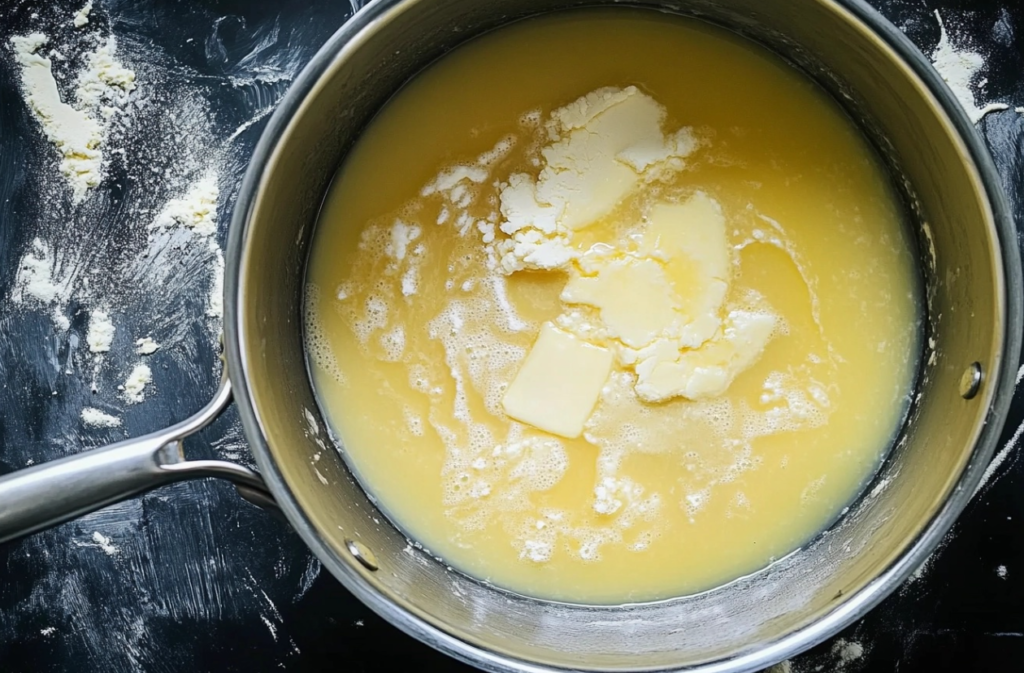
Step 3
Turn the heat up to medium-high and gradually incorporate the milk, whisking steadily until the roux thickens the mixture. Allow it to reach a gentle simmer, then decrease the heat to medium-low and let it simmer softly until the flour texture softens and loses any gritty taste, spanning from 10 to 20 minutes.

Step 4
Turn the heat up to medium-high and gradually incorporate the milk, whisking steadily until the roux thickens the mixture. Allow it to reach a gentle simmer, then decrease the heat to medium-low and let it simmer softly until the flour texture softens and loses any gritty taste, spanning from 10 to 20 minutes.
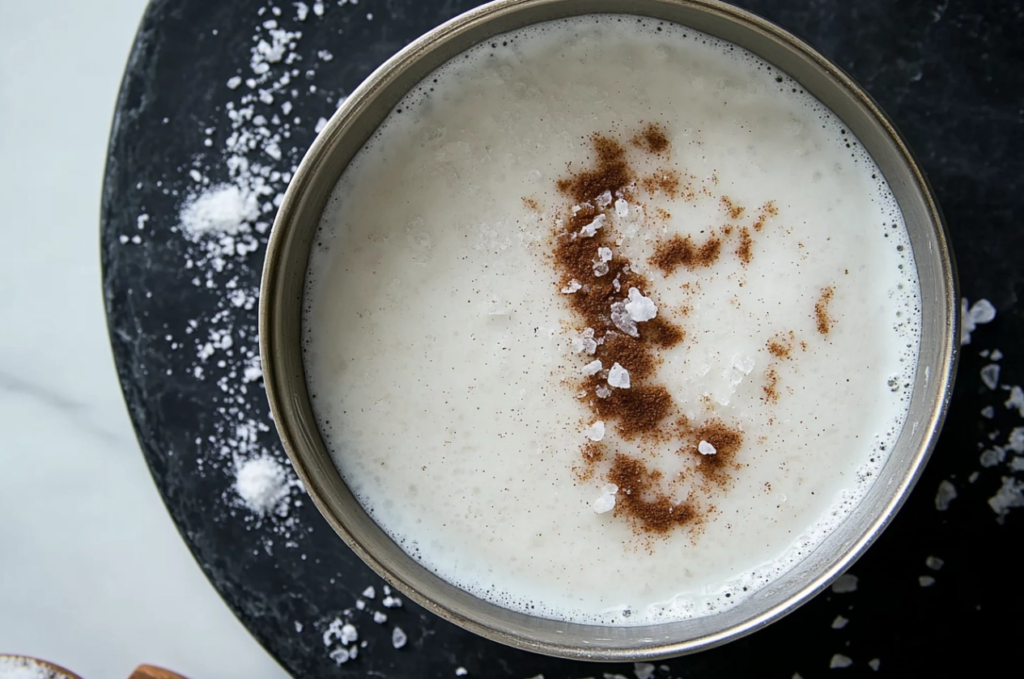
Step 5
Serve hot and enjoy!
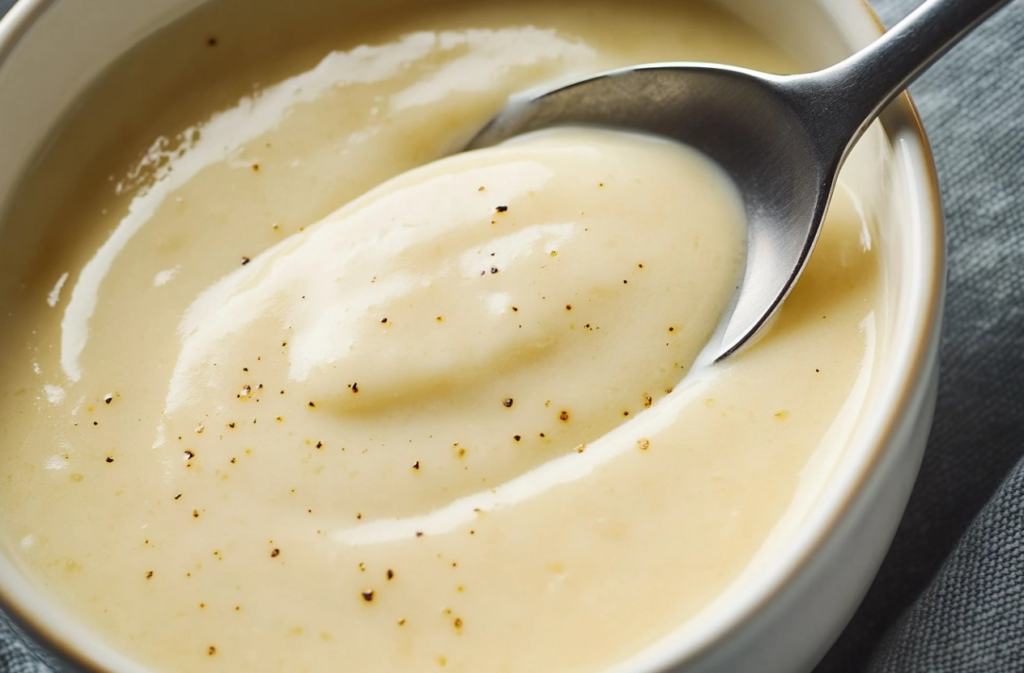
Advanced Techniques and Variations
Flavored Béchamel
To elevate your béchamel sauce recipe, consider infusing it with aromatic flavors. Adding ingredients like onion, bay leaves, or cloves can transform the basic sauce into a rich, flavorful base. For example, gently simmering the milk with a halved onion studded with cloves and a couple of bay leaves for about 10 minutes before making the sauce can impart a delightful, subtle taste. Ensure to sieve the milk prior to incorporating it into your mixture of butter and flour.
Cheese Sauce (Mornay Sauce)
Utilize béchamel sauce as a base to craft a scrumptious cheese sauce, commonly referred to as Mornay sauce. Simply add grated cheese, such as Gruyère or Parmesan, to your béchamel while it’s still warm. Continue stirring until the cheese is thoroughly melted and integrated seamlessly into the sauce. This variation is perfect for dishes like mac and cheese or vegetable gratins, where a creamy, cheesy finish is desired.
Velouté Sauce
Another classic variation is the velouté sauce. Instead of using milk, substitute chicken, veal, or fish stock to make a savory sauce that pairs well with meat and seafood dishes. This method echoes the traditional preparation of béchamel, though the addition of stock imparts a more profound and robust flavor. This variation is especially useful for creating sauces that complement proteins without overpowering them.
Pro Tips
Achieving a perfectly smooth béchamel sauce requires a few tricks. First, always use room-temperature milk to prevent clumping. Maintain a continuous whisking motion while gradually adding the milk to the butter and flour blend to prevent any lumps from forming. If you do end up with a few lumps, don’t worry; simply pass the sauce through a fine-mesh sieve. Mastering these advanced techniques will allow you to make the most of your béchamel sauce and explore its versatility in various recipes. For more advanced recipes, visit cookingwhite.

Maintaining and Storing Béchamel Sauce
Storage Tips
To keep your béchamel sauce fresh, proper storage is crucial. After cooling, place the sauce in a sealed container and refrigerate, where it will remain fresh for up to five days. Make sure the container is well-sealed to prevent any other flavors from seeping in, as béchamel can easily absorb odors from surrounding foods.
Freezing Béchamel
While it’s possible to freeze béchamel sauce recipe, some precautions are needed to maintain its texture. For freezing, pour the sauce into a container suitable for the freezer, allowing some room at the top to accommodate expansion. Mark the container with the current date and place it in the freezer, where it can be stored for up to three months. To use the frozen sauce, defrost it in the refrigerator overnight. Carefully warm the sauce on a low heat setting on the stovetop, continuously stirring to ensure it returns to its creamy texture.
Reheating Tips
Properly reheating béchamel sauce is crucial for maintaining its rich, creamy consistency. Begin reheating by warming the sauce on low in a pan, stirring often to avoid any sticking. If the sauce thickens too much, thin it with a bit of milk, stirring until it reaches the right consistency. To avoid burning, always keep the heat low and stir constantly.
Preventing Skin Formation
When storing béchamel sauce, preventing a skin from forming on the surface is important. As the sauce cools, cover it directly with plastic wrap, pressing the wrap gently onto the surface of the sauce. This simple step prevents air exposure and keeps the sauce smooth and ready to use. Alternatively, mixing in a little butter can help form a creamy layer on the surface.
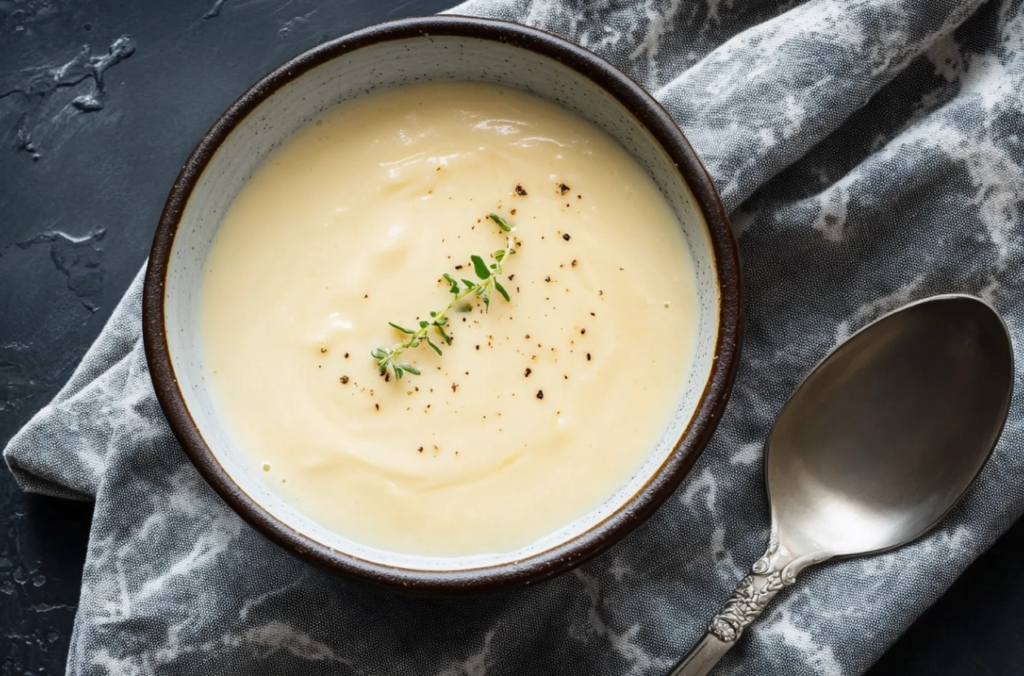
Dietary Adaptations and Substitutions
Gluten-Free Béchamel
For those following a gluten-free diet, making béchamel sauce recipe without wheat flour is simple. Substitute traditional all-purpose flour with gluten-free options such as rice flour or cornstarch for a gluten-free variation. Start by melting the butter, then smoothly blend in your choice of gluten-free flour. Add the milk gradually, stirring continuously, and cook until the sauce thickens. This method creates a delicious, gluten-free béchamel that retains the classic creamy texture.
Dairy-Free and Vegan Options
A dairy-free béchamel sauce recipe is easy to make by substituting the butter and milk. Use plant-based butter or margarine and replace the milk with a non-dairy alternative, such as almond milk or soy milk. Adhere to the traditional approach by melting plant-based butter and mixing in the flour. Gradually add your chosen milk substitute, stirring until thickened. This vegan béchamel is perfect for those avoiding dairy, while still delivering a smooth, rich sauce.
Low-Fat Béchamel
If you are looking to reduce the fat content in your béchamel sauce, there are several simple adjustments you can make. Opt for low-fat or skim milk instead of whole milk and reduce the butter quantity to make it lighter. Alternatively, replace the butter with olive oil for a heart-healthier option. These substitutions result in a lighter version of the sauce without compromising its creamy consistency.
Lactose-Free Adaptation
Creating a lactose-free béchamel sauce is straightforward with a few ingredient swaps. Use lactose-free milk and lactose-free butter in place of the regular versions. The preparation method remains the same, ensuring a sauce that is both smooth and suitable for those with lactose intolerance. This adaptation allows everyone to enjoy the classic taste of béchamel without any discomfort.

Common Questions About Béchamel Sauce Recipe
What is the difference between béchamel and Alfredo sauce?
Although béchamel and Alfredo sauces both boast a creamy texture, their components and methods of preparation vary significantly. Béchamel is a classic white sauce made with butter, flour, and milk. Alfredo sauce, on the other hand, is known for its richness, typically made with heavy cream, butter, and Parmesan cheese. The key distinction lies in the flavor profile: béchamel is subtle and versatile, while Alfredo is more decadent with a cheesy, garlic-infused taste.
Is it possible to prepare béchamel sauce in advance?
Certainly, you can make béchamel sauce beforehand. Keep it stored in a sealed container in the fridge, where it will remain fresh for up to five days. When it’s time to use it, slowly warm the sauce on the stove over low heat, stirring consistently to avoid forming lumps and to preserve its creamy consistency.
Why did my béchamel sauce turn out lumpy?
Lumpy béchamel sauce often results from adding the milk too quickly or not whisking enough during cooking. To ensure smoothness, add the milk slowly and whisk constantly during the addition. If lumps still form, don’t panic; you can strain the sauce through a fine-mesh sieve to restore its creamy consistency.
Is béchamel sauce keto-friendly?
Traditional béchamel sauce is not keto-friendly due to the flour and milk, which are high in carbohydrates. However, you can adapt it for a keto diet by substituting almond flour for regular flour and using heavy cream instead of milk. This modification results in a lower-carb version that fits within keto dietary guidelines while still providing a rich, creamy texture.
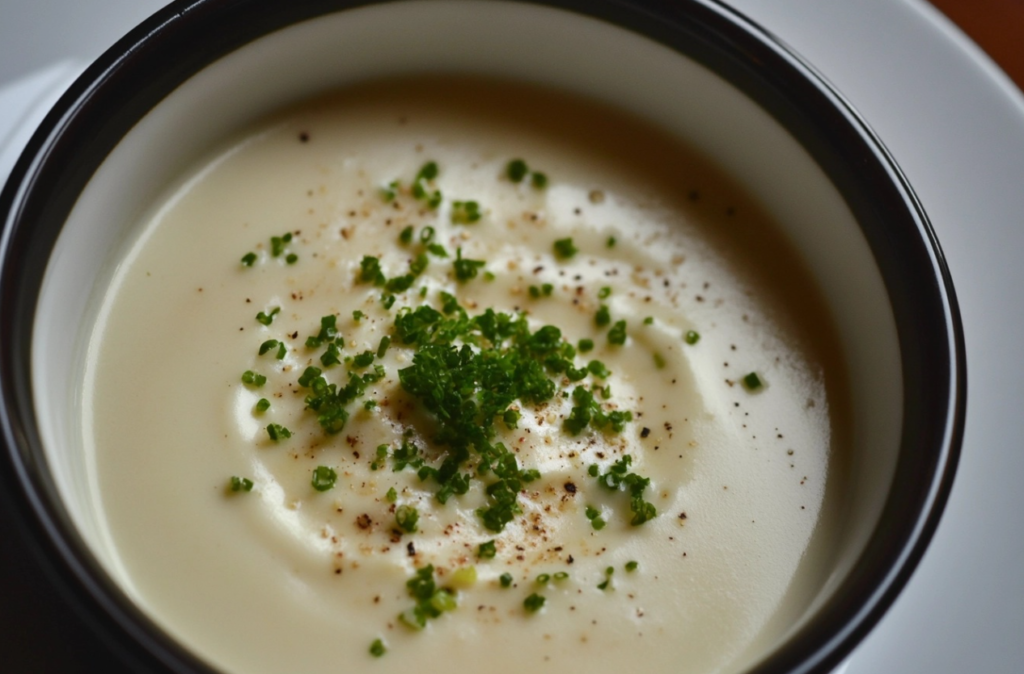
Conclusion and Additional Resources
Summary
To conclude, mastering béchamel sauce recipe opens up a world of culinary possibilities. This adaptable sauce forms the foundation for numerous beloved dishes, including creamy gratins and lasagnas. By understanding the basics and exploring advanced techniques, you can enhance your cooking repertoire and impress with delicious, homemade meals. Whether you prefer a simple béchamel or want to experiment with variations like cheese or velouté sauces, the foundation remains the same.
Encouragement
Don’t be afraid to get creative with your béchamel sauce. After perfecting the basic recipe, experiment by incorporating various spices or herbs to tailor the flavor to your liking. You can also use béchamel as a base to create other sauces or incorporate it into your favorite dishes for added richness. The more you experiment, the more adept you’ll become at utilizing this indispensable sauce in your cooking.
Additional Resources
For further reading and inspiration, there are many excellent resources available online that provide tips and recipes for making the perfect béchamel sauce. Exploring different culinary websites can give you fresh ideas on how to use béchamel in both traditional and innovative ways. Additionally, consider checking out cooking classes or tutorials that focus on sauce-making techniques to enhance your skills in the kitchen.
Call to Action
Armed with all the necessary information, now’s the time to dive into cooking! Collect your ingredients, follow the instructions, and whip up a tantalizing béchamel sauce today. Remember to share your culinary creations with loved ones or even showcase them on social media platforms. By sharing, you can inspire others to try their hand at making this classic sauce, expanding their culinary horizons and bringing more delicious meals to the table. Happy cooking!

